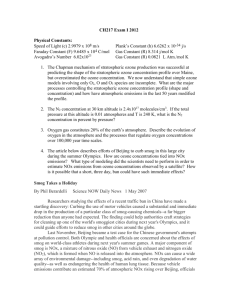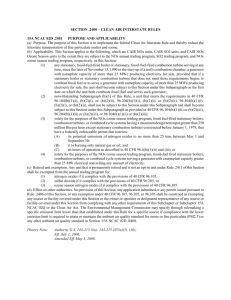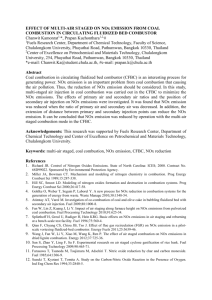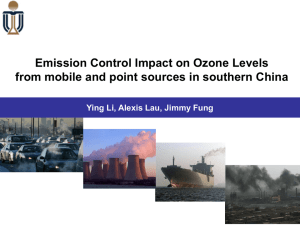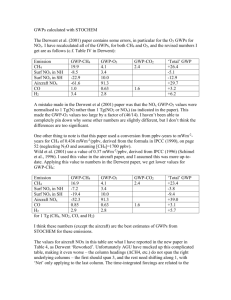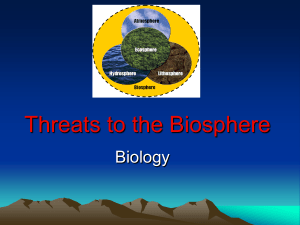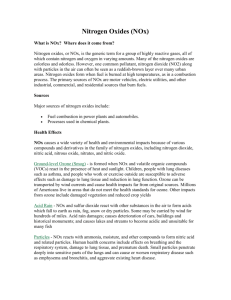acidification and eutrophication of soil ecosystems
advertisement
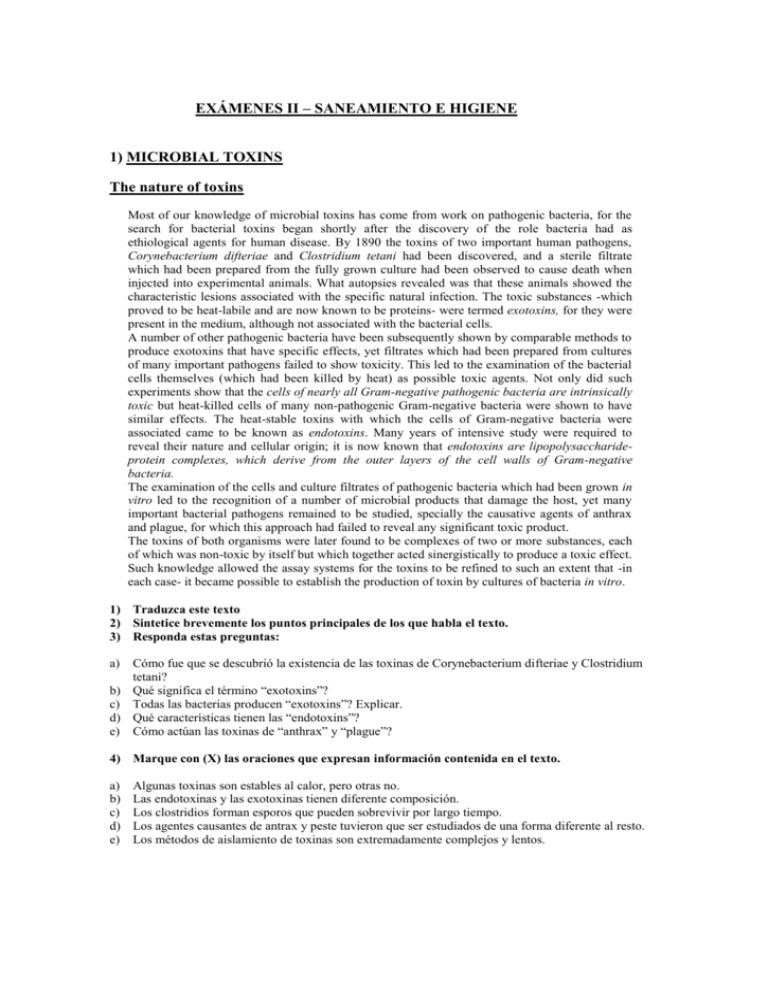
EXÁMENES II – SANEAMIENTO E HIGIENE 1) MICROBIAL TOXINS The nature of toxins Most of our knowledge of microbial toxins has come from work on pathogenic bacteria, for the search for bacterial toxins began shortly after the discovery of the role bacteria had as ethiological agents for human disease. By 1890 the toxins of two important human pathogens, Corynebacterium difteriae and Clostridium tetani had been discovered, and a sterile filtrate which had been prepared from the fully grown culture had been observed to cause death when injected into experimental animals. What autopsies revealed was that these animals showed the characteristic lesions associated with the specific natural infection. The toxic substances -which proved to be heat-labile and are now known to be proteins- were termed exotoxins, for they were present in the medium, although not associated with the bacterial cells. A number of other pathogenic bacteria have been subsequently shown by comparable methods to produce exotoxins that have specific effects, yet filtrates which had been prepared from cultures of many important pathogens failed to show toxicity. This led to the examination of the bacterial cells themselves (which had been killed by heat) as possible toxic agents. Not only did such experiments show that the cells of nearly all Gram-negative pathogenic bacteria are intrinsically toxic but heat-killed cells of many non-pathogenic Gram-negative bacteria were shown to have similar effects. The heat-stable toxins with which the cells of Gram-negative bacteria were associated came to be known as endotoxins. Many years of intensive study were required to reveal their nature and cellular origin; it is now known that endotoxins are lipopolysaccharideprotein complexes, which derive from the outer layers of the cell walls of Gram-negative bacteria. The examination of the cells and culture filtrates of pathogenic bacteria which had been grown in vitro led to the recognition of a number of microbial products that damage the host, yet many important bacterial pathogens remained to be studied, specially the causative agents of anthrax and plague, for which this approach had failed to reveal any significant toxic product. The toxins of both organisms were later found to be complexes of two or more substances, each of which was non-toxic by itself but which together acted sinergistically to produce a toxic effect. Such knowledge allowed the assay systems for the toxins to be refined to such an extent that -in each case- it became possible to establish the production of toxin by cultures of bacteria in vitro. 1) Traduzca este texto 2) Sintetice brevemente los puntos principales de los que habla el texto. 3) Responda estas preguntas: a) Cómo fue que se descubrió la existencia de las toxinas de Corynebacterium difteriae y Clostridium tetani? b) Qué significa el término “exotoxins”? c) Todas las bacterias producen “exotoxins”? Explicar. d) Qué características tienen las “endotoxins”? e) Cómo actúan las toxinas de “anthrax” y “plague”? 4) Marque con (X) las oraciones que expresan información contenida en el texto. a) b) c) d) e) Algunas toxinas son estables al calor, pero otras no. Las endotoxinas y las exotoxinas tienen diferente composición. Los clostridios forman esporos que pueden sobrevivir por largo tiempo. Los agentes causantes de antrax y peste tuvieron que ser estudiados de una forma diferente al resto. Los métodos de aislamiento de toxinas son extremadamente complejos y lentos. 2) ENVIRONMENTAL BENEFITS OF NOx CONTROL IN NORTHWESTERN EUROPE Five environmental problems have been identified, which should see significant improvement in the United Kingdom, if action is taken within the United Nations Economic Comission for Europe (UN ECE) Second NOx protocol to control NOx emissions. These problems are: acidification and eutrophication of soil ecosystems; episodic peak ozone and human health; ozone damage to crops and forest trees; wintertime NOx pollution episodes and summertime fine particulate formation and human health. There are a range of environmental and health thresholds that can be used as a guide to setting NOx emission reduction targets for these problems within the proposed Second NOx Protocol. It is recognized however, that achieving some of these targets will require actions beyond those regarded as feasible even if their desirability is acknowledged. These targets can at least provide bench marks against which agreed reductions can be assessed, within the context of a mullet-pollutant mullet-effect framework to the proposed Second NOx Protocol. Introduction It has been understood for a considerable time that NOx emissions from motor vehicles and power stations cause urban and regional scale photochemical smog and, when deposited, cause acidification and eutrophication effects in various ecosystems (1). In Europe in 1988, this understanding led the member states of the United Nations Economic Commission for Europe to agree the Sofia protocol to the International Convention on Long Range Transboundary Air Pollution (2). The main provision of the Sofia protocol aims to freeze NOx emissions at their 1987 levels from the year 1994 onwards (3). There is a case for taking much firmer steps in Europe to decrease NOx emissions over the next few decades within the framework of the proposed Second NOx Protocol. Over much of northwestern Europe, nitrogen dioxide (NO2) now dominates over sulfur dioxide (SO2) as the acidic gas in highest concentration on a ppb basis (4). The nitrate content of suspended particulates has risen steadily in absolute terms and relative to sulfate aerosol in southern England since 1954 (5). The trends of nitrate in rain in Scandinavia have remained constant for two decades while those for sulfate have decreased (6). Nitrate levels in ice cores in southern Grenland have continued to increase whereas sulfate levelled off in 1970 or thereabouts (7). The Thousand lakes Survey in Norway has recorded a doubling in the nitrate content of 305 lakes over the period 1974-75 to 1986, despite little changes in pH and sulfate (8). More recently, from 1986-1994, sulfate levels in these lakes have declined yet nitrate levels remained constant(9). NOx plays an important role in an increasing range of environmental impacts over a widening range of spatial scales from the local and urban to the global scale (10); some of these impacts are illustrated in Figure 1. NOx emissions are implicated in wintertime urban pollution episodes (11), photochemical ozone formation (12), acidification of remote soil and freshwater ecosystems (13), fertilization of sensitive soil and plant ecosystems leading to changes and reductions in biodiversity (14), stimulation of plankton blooms in marine waters (1516), global tropospheric ozone production (17), and the increase in the levels of ozone since preindustrial times over large parts of the troposphere and the build up of greenhouse gases, such as ozone, methane and the HFCs and of some ozone depleting trace gases such as methyl chloroform and HCFC-22 (19-20). In all these impacts, NOx does not act alone. Suspended fine particulate matter, along with NO2 is an important component of wintertime urban pollution episodes (11). Both NOx and particles are emitted by diesel vehicles and some measures to control one can lead to exacerbation of the other (21). NOx and hydrocarbon emissions both contribute to photochemical smog formation (12). NOx, SO2, HCl and ammonia together control the acidification of remote ecosystems and the sutrophication of terrestrial and marine ecosystems (10). NOx, carbon monoxide, methane and hydrocarbons together control the oxidizing capacity of the troposphere (17-19). Nitrate aerosol is only one component of summertime haze, others include sulfuric acid and ammonium sulfate (22). In adressing these impacts therefore care has been taken to include the role of NOx and of other pollutants in quantifying the likely impacts of NOx emission reductions. Here, computer modelling studies are described which assess the likely impacts in the United Kingdom of measures to reduce emissions of NOx in the UK and in the rest of Europe. The aim is to use the UK as an example, to discuss the different aspects of a mulletpollutant mullet-effect approach to a Second NOx Protocol. Table 1 contains a summary of models employed. These studies are set in the context of the other pollutants involved and address the environmental problems listed below: - acidification and eutrophication of sensitive soil ecosystems; - photochemical ozone formation and its impacts on human health; - regional-scale ozone levels and vegetation damage; - wintertime NO2 levels and human health effects; and summertime fine particle formation and human health effects. ACIDIFICATION EUTROPHICATION ECOSYSTEMS OF AND SOIL Soil acidification is mostly concentrated in European regions north of the Alps and it is here that acidification is known to have caused a severe reduction in base cation saturation of soil in many areas. Where this reduction has occurred, lakes and streams may receive acidified waters containing elevated concentrations of potentially toxic forms of aluminum. Sulfur deposition may pass through the sensitive soils of north and central Europe almost entirely in the form of sulfate, contributing to acidification of soils by enhanced leaching of aluminum. [Acidification effects in the UK have been detected in the upland areas of Wales (24), the penines, Galloway, and the Highlands of Scotland (25). The situation with nitrogen deposition is much more complicated. Most forest ecosystems are nitrogen deficient and nitrogen will initially act as a nutrient. Nitrogen may accumulate in the forest, either in the living biomass or in the soil. The increased availability of nitrogen will lead to enhanced growth and a balancing increase in the uptake of base cations, contributing to soil acidification (26). If high nitrogen deposition loads persist, nitrate leaching will occur with the associated leaching of base cations and soil acidification in the same way as sulfur. In Scandinavia and in the UK, nitrate leaching is generally minimal whilst in continental Europe, high nitrate leaching levels are common (10). Nitrogen eutrophication effects are far less well-documented than acidification effects, and lead to changes in the competitive interactions between plant species and hence to changes in species composition in sensitive ecosystems. In The Netherlands, severe effects due to nitrogen deposition have been observed. In the UK and southern Scandinavia, acosystem changes have been observed in areas with high nitrogen deposition (27), but in the remote north and western fringes of Europe, no significant eutrophication effects have been observed. The sensitivity of the soil ecosystems to acidification and eutrophication depends on a complex range of physical, chemical, ecological, mineralogical, geological and hydrological factors, which are highly spatially variable. For sensitivity to be quentified, the concept of critical load may be used. This represents a quantitative measure of the exposure to one or more pollutants below which harmful effects do not occur according to present knowledge. Methodologies have been described to quantify and map critical loads for acidification and eutrophication for sulfur and nitrogen across Europe and within the UK. Ecosystems are likely to be protected in the long term if deposition loads are below critical loads and are likely to suffer long-term deterioration if the converse is the case. The exceedance of these critical loads can be ascertained by overlaying the critical loads maps with maps of the deposition loads of the particular damaging pollutants. In this study, critical loads maps are overlaid with model estimates of current and future deposition loads to assess the impact of NOx controls in the UK and in the rest of Europe.] 1) Nombre al menos siete problemas ambientales relacionados con la emisión de NOx. 2) Decida si las siguientes afirmaciones son verdaderas (V) o falsas (F) e indique en el texto las líneas que justifican su decisión. a) b) c) d) e) El smog es producto de la combinación de NOx y de las emisiones de los hidrocarburos. El 2º Protocolo de NOx pretende mantener los niveles de emisión en los valores registrados en 1987, al igual que el protocolo de Sofía. Los NOx y partículas emitidas por los automóviles pueden controlarse independientemente, sin que se produzcan efectos adversos. Al analizar los episodios ambientales basta con considerar el efecto de los NOx. Los estudios que menciona el artículo, basados en modelos computacionales, pretenden tomar al Reino Unido como ejemplo para debatir los probables impactos sobre el mismo de la reducción de los NOx, tanto en el reino Unido como en Europa. 3) Responda las siguientes preguntas: a) Considerando Europa noroccidental, ¿cuál es el gas acídico predominante? Enumere sintéticamente los datos que brinda el artículo y que le permitan justificar su respuesta. b) Cuál es la causa de la disminución de la saturación de cationes básicos en los suelos? c) Cómo se puede determinar la sensibilidad de un suelo a la acidificación y a la eutroficación. 4) Traduzca las partes señaladas entre corchetes. del texto
